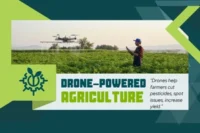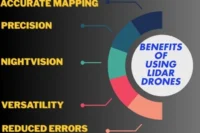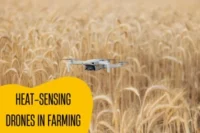10 Practical Benefits of Using Drones in Agriculture
Published: 5 Aug 2025
Using a drone for farm use is not just about flying a gadget, it’s about saving time, cutting costs, and getting better yields. These compact tools can scan fields, spot pests, check crop health, and even map soil conditions—all without stepping foot outside. Farmers no longer have to rely on guesswork or endless field walks. A drone gives you fast, accurate data you can use right away. Whether you run a small plot or manage hundreds of acres, drones make smart farming easier. They help you make decisions that protect your crops, your money, and your time.
In this article, we will explore how drones help farmers boost productivity and work more efficiently.
1.Let drones fly your farm not your feet
Why walk miles across your farm when a drone can scan it all in minutes? With a drone, you can cover large fields quickly without even stepping outside. It’s perfect for daily or weekly crop checks, especially during busy seasons. Whether you’re tracking plant growth or looking for signs of stress, a drone gives you the full picture. No more wasting hours walking rows or driving around. It’s a big win on hot days, after rainfall, or in tough terrain where walking isn’t easy. You save time, conserve energy, and still stay fully in control.
2.See What You Can’t See from the Ground
Sometimes, the biggest problems in your field are the ones you can’t see from the ground. Drones equipped with multispectral cameras can detect early signs of crop stress, disease, or pest activity—long before they’re visible to the naked eye. These cameras pick up changes in plant health that aren’t obvious from a field walk. Spotting issues early means you can act faster and avoid larger damage. This leads to less crop loss, better planning, and stronger harvests. In short, drones help you catch problems before they spread.
3.Real-Time Data You Can Trust
One of the biggest advantages of using a drone on the farm is access to real-time data you can trust. Instead of waiting days for reports or relying on rough estimates, you get instant visuals and stats from the air. That means you can make same-day decisions—whether it’s adjusting your irrigation schedule, planning pesticide application, or getting ready for harvest. The data is accurate, visual, and easy to understand. You see exactly what’s happening in your fields right now, not last week. That kind of speed helps you stay ahead and act before small issues turn into big losses.
4.Cut Back on Fertilizers and Sprays
Drone in the farm helps you to apply fertilizers and sprays only where they’re actually needed. Instead of covering the entire field and wasting costly inputs, drones let you target specific areas showing signs of stress or pest problems. This precision cuts down on overuse, which not only saves money but also protects the environment. You avoid runoff, reduce chemical exposure, and still keep your crops healthy. It’s smarter, cleaner farming. By applying less but doing it right, drones help you get better results without wasting time and effort.
5.Keep an Eye on Everything From Above
You can fly it over your fields to check fence lines, monitor water tanks, and even keep an eye on livestock if needed. This is especially helpful on large or remote farms where walking or driving to every corner takes too much time. With a quick flight, you can spot broken gates, low water levels, or animals in the wrong place. It’s fast, easy, and gives you peace of mind without leaving your spot. Drones help you stay in control of the whole farm.
6.Small Farms Can Use Them Too
You don’t need hundreds of acres to see the benefits— even small farms can get big results with basic drone models. Whether you are managing a fruit orchard, rice paddy, or vineyard, a drone helps you monitor crops, catch problems early, and plan tasks more efficiently. It’s a smart investment with a solid return, even on limited land. Small landholders often don’t have the time or labor to walk their fields every day, and that’s where drones really shine. They make high-tech farming simple, affordable, and accessible.
7.Cut Labor and Fuel Costs
Bringing a drone onto your farm can cut down labor and fuel costs. With fewer tractor runs needed for scouting or checking field conditions, you save on diesel and reduce wear and tear. Drones also lower the need for manual labor—no more walking rows or sending workers to inspect distant plots. A single drone flight can cover the same area that used to take hours on foot or by vehicle. This not only saves money but also frees up time and manpower for other important tasks around the farm. It’s faster, cheaper, and far more efficient.
8.Prevent Crop Losses Before They Happen
One of the biggest advantages of using drones in the field is getting early warnings before problems get out of hand. Drones can spot signs of stress, disease, or fungal patches long before they spread across your crops. For example, if a drone detects signs of a fungal infection in one corner of your field, you can treat it immediately and stop it from spreading. That kind of early action can save your harvest and protect your profits. Instead of reacting too late, drones help you stay one step ahead—keeping your fields healthy and productive.
9.Helps During Every Stage of Farming
During planting, you can survey the land and plan more efficiently. As crops grow, drones help you monitor progress, spot issues early, and make informed decisions. And at harvest time, they give you a clear view of which areas are ready, helping you prioritize and plan better. Over time, you can even compare seasonal data to see what’s working and what needs adjustment. It’s like having a field diary from the sky, guiding you through every stage of the farming cycle.
10.Drones Don’t Replace Farmers—They Help Them
Using a drone doesn’t mean replacing the farmer, it means giving them better tools to work with. Drones are here to support, not take over. They provide useful data, quick field views, and early warnings, but the real decisions still come from the farmer’s experience and instinct. Think of a drone as another tool in your kit—like a shovel or tractor, just smarter. You’re still in charge, only now you’ve got clearer info, faster insights, and more control. The human touch stays at the center. The drone just helps you farm with more confidence and less guesswork.
Conclusion
Drones make farming faster, smarter, and more efficient without replacing the farmer. They help you spot issues early, reduce labor and fuel costs, and make better decisions with real-time data. Whether you’re managing a small plot or a large farm, drones offer clear benefits at every stage—from planting to harvest. You save time, cut waste, and protect your crops with less guesswork. It’s not about flying gadgets, it’s about farming with confidence and control.





